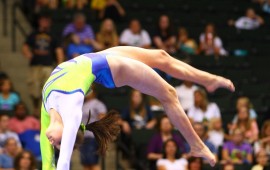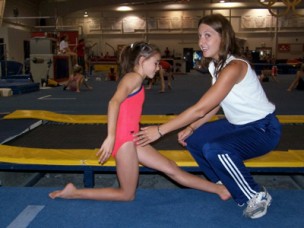Gymnastics Injury Prevention Focus: The Spine!
Author: admin

If you have kids in gymnastics, (or if you are in the sport) no matter the age or discipline, you  know that back pain is a part of the package.
know that back pain is a part of the package.
Whether it is an incident that happened (fall, tweaked muscle, etc.) or simply overuse, back pain can bother your athlete, and create issues outside of the gym as well. It affects sleep, sitting in school, being physically active, alertness (if sleep is disturbed), posture, and mood…. It is no fun!
Especially with the Olympics this coming Summer in London, we can watch all of America’s Elite’s compete for that coveted spot on the team. In order to not have back pain effect them, their training, their competition and their careers, they have to go through many exercises for prevention and strengthening to avoid any back issues that may come up. It is the basics (strength, alignment, flexibility) that any and all gymnasts need to remember- from the Level 5 to the International Elite, to keep healthy!
Here are some common descriptions of categories of pain and diagnosis that gymnasts go through:
- New motions. Any time an athlete tried to gain a new skill, he or she will try it over and over again. Using new muscles does not constitute injury, but just may be muscle pain from getting used to new patterns of motion. This has to happen in the learning process, of preparing skills, progressing them, etc. If pain is there because of this, limiting numbers may help or alternating days that the skills are performed until the numbers are lower, and the body is acclimated.
- Hard to take a deep breath. Most often, this is a spine that is mal-aligned, and examples of this are ribs being out of place, facet joints not being in alignment, muscles being tight and pulling individual spine levels out of sync (rotating, out to side, etc.). With a proper visit to a physical therapist or chiropractor, this can easily subside.
- Strained muscle. This may happen if you land awkwardly, fall, or just simply use a muscle the wrong way. These injuries should not be pushed through, because then the muscle will never recover. You can see a physical therapist who will use a technique called Active Release Technique, to get blood flowing properly, release scar tissue and tension, and restore proper motion. Also, if a muscle is pulled, strained or torn, stretching should be avoided in static positions (where you hold it). This is because you do not want to strain an already guarded muscle- it will only make it guard more, and then delay healing. Certain advanced flexibility techniques can be used, such as contract/relax, inhibition, and more…again, your PT can help you. Remember, hips, shoulders, ribs, abs and more are all part of your “spine” because they all attach there on one end… so the connection begins!
- Stress reaction/fracture. This is the most common injury, chronic or acute, that we deal with in gymnasts, mostly at higher levels, or at lower levels with improper training techniques or fitness/strength levels for the sport demand. Most of the time, it hurts, sharply, to bend forward or backwards, sometimes to twist, sometimes to run, and specifically in 1 or 2 spots on the spine. It also hurts if the spine is pushed on during a medical examination, in a focal point. First line of diagnosis is clinical exam. Second is usually x-ray. Then, depending on the doctor, an MRI is ordered or a bone scan to see what the bones look like as well as the surrounding muscle and connective tissue. This is not something to delay in diagnosis, as the injury can progress to more serious diagnoses and pain, and longer recovery. Better to “rule it out” than to “wait it out”.
- Muscle tightness. The three main muscles that can cause back pain and are not even back muscles, are the hip flexors, the hamstrings and the glutes.
- First, the hip flexors can contribute because gymnasts use them to kick, leap, dance, hold their legs up, swing bars and more. They get overworked (and understretched) and then they pull the hips to tilt forward (because they attach at the front part of your spine!). So, keeping these flexible is important.
- The hamstrings (the back part of your thigh) are used every time you squat, jump or run. They are also used to kick your back leg behind your or hold it up. They are integral in balance when you are on one foot, to prevent your upper body from jackknifing on your lower body (like when you land a layout stepout on beam for example). So, keep these flexible as well!
- And third, your glutes. They are used each time you jump, squat and land. They are used to turn your hips in and out, to balance you from turning out on single leg landing skills, and when strong, are the powerhouse of your run. Keeping them happy will make them pull at your sacrum less, meaning that your SI joint stays happier!
Here are some ways to try to prevent back pain from happening in the first place!
- Flexibility. Stretch the right way, paying as much attention to form as possible. There are great presentations and articles on www.medgym.net that show positions and pictures for split position, back health, etc. “Hinge Theory” is a great way of thinking for why you need to be flexible in other areas of the body to help with the back. Think of the back as a slinky- each level having to bend a little bit with arching, and with rounding. As well, think of the whole body as a slinky- with 1/3 of the stress on the shoulders and rib cage, 1/3 on the back, and 1/3 on the hips to provide a really nice arch. If all of the parts take a little but of the force, then no single part is stressed. If, for instance, you have bad shoulder flexibility, then, when you arch, your spine has to do more, or your hips. If you are turned out because your hip isn’t flexible, then your lower back is rotated, putting lots of stress on the Sacrum and the lower spine. Spend as much time stretching your shoulders, hips, ribs and abs as you do strengthening, and you will be healthy and have great positions, too!
- Relaxation. Don’t over stretch. If it hurts a lot when you stretch, you are probably guarding anyway, and then not getting the benefit from the stretch and making the muscle more mad than open. Make sure you align your body and relax muscles into place to get the best position you can. Pushing down on someone is a stretch is not always the best answer and can cause injury!
- Shoulders and hips. Most of the time, stretching is done wrong if the shoulders and the hips are not aligned, or “square.” When stretching in turn out, you encourage turn out. If your shoulders are turned, and therefore your spine is rotated, you are encouraging this pattern and then aligning shoulders, ribs, hips and feet becomes a struggle instead of a memorized position. Think of falling off the beam when doing a skill that ends in a handstand step down (handstand itself, walkover, back handspring, layout step out, etc.). If your hips are “open” or turned out while your hands are on the beam, this is how you are setting yourself up to come down.
Try testing your actual alignment. Have a friend hold a camera, and you will kick up to handstand. While holding the handstand, try to split to left or right (best side) as far as you can, and check your alignment. Then, have another teammate square your hips and your shoulders to perfect. As they do this, your split will get worse, because it stresses the back and the hip flexors. This will prove to you how effective and worthwhile stretching square is, as well as focusing on your hips!
So, from now on, watch when athletes fall on beam, or when their leaps are not squared. You will soon notice maybe that they need some work on their shoulders or their hips. And, the next time that you have low back pain, focus on relaxing the back muscles. But, also focus on shoulder and hip flexibility- and I bet your back may feel better!
I hope this helps to keep you as healthy as possible in the gym and out… Happy Flipping!
